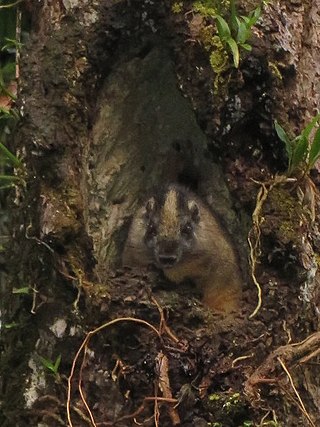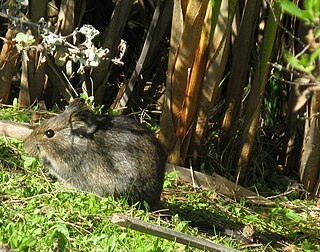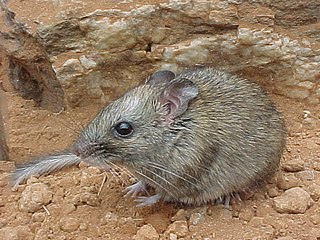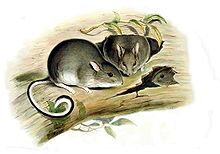
The brush-tailed phascogale, also known by its Australian native name tuan, the common wambenger, the black-tailed mousesack or the black-tailed phascogale, is a rat-sized arboreal carnivorous marsupial of the family Dasyuridae, characterized by a tuft of black silky hairs on the terminal portion of its tail. Males of this species do not live past the age of one, as they die after reproducing.

The kowari, also known by its Diyari name kariri, is a small carnivorous marsupial native to the gibber deserts of central Australia. It is the sole member of the genus Dasyuroides.

The Muridae, or murids, are either the largest or second-largest family of rodents and of mammals, containing approximately 870 species, including many species of mice, rats, and gerbils found naturally throughout Eurasia, Africa, and Australia.

The Malagasy rodents are the sole members of the subfamily Nesomyinae. These animals are the only native rodents of Madagascar, come in many shapes and sizes, and occupy a wide variety of ecological niches. There are nesomyines that resemble gerbils, rats, mice, voles, and even rabbits. There are arboreal, terrestrial, and semi-fossorial varieties.

The Old World rats and mice, part of the subfamily Murinae in the family Muridae, comprise at least 519 species. Members of this subfamily are called murines. In terms of species richness, this subfamily is larger than all mammal families except the Cricetidae and Muridae, and is larger than all mammal orders except the bats and the remainder of the rodents.

Maclear's rat is an extinct large rat endemic to Christmas Island in the Indian Ocean. It was one of two species of rat native to Christmas Island, alongside the bulldog rat. Abundant, unfamiliar with and seemingly unafraid of humans, large numbers of the creatures emerged and foraged in all directions at night. Making querulous squeaks, the rats entered the Challenger expedition's tents and shelters in 1886, ran over sleepers, and upset everything in the search and fight for food. Maclear's rat might have been responsible for keeping the population of the Christmas Island red crab in check, as recent numbers of the crab are greater than in the past. It is thought that black rats inadvertently introduced by the expedition infected the Maclear's rats with a disease, which in turn could have contributed to the species' decline. The last recorded sighting was in 1903, although it is possible that Maclear's rats hybridized with black rats. A hard tick, described as an ectoparasite of Maclear's rat, is also thought to be extinct.

The blesmols, also known as mole-rats, or African mole-rats, are burrowing rodents of the family Bathyergidae. They represent a distinct evolution of a subterranean life among rodents much like the pocket gophers of North America, the tuco-tucos in South America, and the Spalacidae from Eurasia.
The earless water rat is a New Guinea rodent, part of the Hydromys group of the subfamily of Old World rats and mice (Murinae). It is the only species in the genus Crossomys. This species is probably most closely related to Baiyankamys. It is still unclear to which species this group is related. It is one of the most aquatically adapted rodents of the world.

The toros or brush-tailed rats, genus Isothrix, are a group of spiny rats found in tropical South America, particularly in the Amazon Basin.

Oligoryzomys nigripes, also known as the black-footed colilargo or the black-footed pygmy rice rat, is a rodent in the genus Oligoryzomys of family Cricetidae. Oligoryzomys nigripes is a species that has been further divided into different sister taxa throughout history. It is found in different countries in South America. It is a large species with long ears, dark yellow to dark brown upperparts, sharply delimited from the whitish underparts, and often a pink girdle on the chest. This species of rat spends much of its life among the trees. The karyotype is 2n = 62, FNa = 78–82.

The Malagasy giant rat, also known as the votsotsa or votsovotsa, is a nesomyid rodent found only in the Menabe region of Madagascar. It is an endangered species due to habitat loss, slow reproduction, and limited range Pairs are monogamous and females bear only one or two young per year. It is the only extant species in the genus Hypogeomys; another species, Hypogeomys australis, is known from subfossil remains a few thousand years old.

The shrewlike rats, genus Rhynchomys, also known as the tweezer-beaked rats are a group of unusual Old World rats found only on the island of Luzon in the Philippines. They look a great deal like shrews and are an example of convergent evolution. Shrewlike rats evolved to be vermivores and insectivores feeding on soft-bodied invertebrates associated with leaf litter.

African vlei rats (Otomys), also known as groove-toothed rats, live in many areas of sub-Saharan Africa. Most species live in marshlands, grasslands, and similar habitats and feed on the vegetation of such areas, occasionally supplementing it with roots and seeds. The name "vlei" refers to the South African term for intermittent, seasonal, or perennial bodies of standing water.

The brush-tailed rabbit rat is a species of rodent in the family Muridae. It is found in Australia and Papua New Guinea.

Melomys is a genus of rodents in the family Muridae. Members of this genus live in the wet habitats of northern Australia, New Guinea, Torres Strait Islands and islands of the Indonesian archipelago.

The golden-backed tree rat is a species of rodent in the family Muridae, found only in Australia.

The central rock rat, also known as the central thick-tailed rock-rat, Macdonnell Range rock-rat, and Australian native mouse, is a critically endangered species of rodent in the family Muridae, endemic to Australia.
The Capricorn rabbit rat is an extinct species of rodent from Queensland, Australia. It was described as a new species in 2010 on the basis of Pleistocene and Holocene dental remains. The specific name refers to the Capricorn Caves in Queensland, one of the locations where remains were unearthed. Some of the subfossil material post-dates the European settlement of Australia, so the Capricorn rabbit rat is a modern extinction. Since there has not been a targeted survey for the Capricorn rabbit rat, there is a thin hope of its survival, although this is unlikely.

Hydromyini is a very large, diverse tribe of muroid rodents in the subfamily Murinae. They are the dominant native rodents in Australasia and one of only two native rodent groups there, the other being the R. fuscipes group of the genus Rattus in the tribe Rattini. They are also found in parts of Southeast Asia.
















